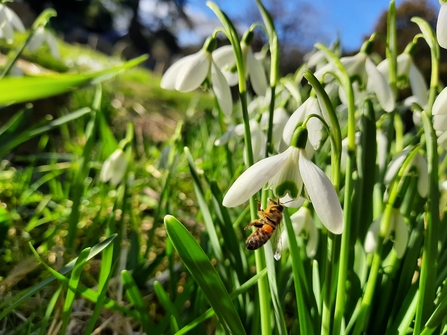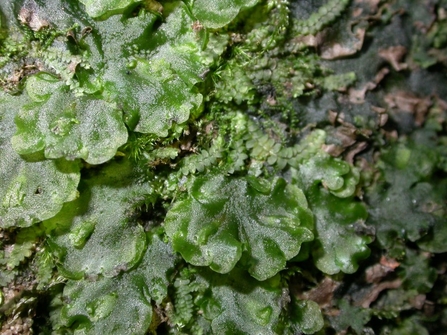
A bee visiting a snowdrop in an Oxfordshire churchyard. Picture: Pete Hughes
Inkpen Crocus Field. Picture: Adrian Wallington

A bee visiting a snowdrop in an Oxfordshire churchyard. Picture: Pete Hughes
Snowdrops are often the first wild flowers we see. Last year we found crowds of these pure white petals on 1 February already being swarmed by early bees. Our Warburg Nature Reserve near Henley has a fantastic display that we always look forward to. But did you know the snowdrop may not actually be native to this country? Although native to woodlands and fields on the continent, it was not recorded growing wild in the UK until the 18th century.
Buff-tailed bumblebee (Bombus terrestris). Picture: Richard Burkmar
Unlike honeybees, bumblebees do not keep their colonies alive over winter. In social species only the queen survives the winter, usually hiding in a hole in the ground. At this time of year queens start emerging from their torpor to look for new nest sites. Look out for species like the buff-tailed bumblebee and the aptly-named early bumblebee hovering low over the ground in meadows, gardens and woodland like our Dry Sandford Pit reserve near Abingdon.

Brimstone by Neil Phillips
Small tortoiseshells, peacocks and brimstones are some of the iconic British butterfly species that overwinter as adults, often hiding in the corners of windows in our houses and sheds. In February these hardy survivors start to make their first forays out to find nectar. Whitecross Green Wood near Bicester is a good reserve for early butterflies.

Velvet shank fungus growing out of a fallen tree. Picture: Lily O'Neill
We've already seen some fantastic specimens of the attractive, amber-coloured velvet shank fungus this year. One of the few fungi to be found when frost and snow are about, it grows out of elm, ash, beech and oak trees. Seen from beneath, its translucent gills glow orange against their curving, dark stems. Our Foxholes nature reserve in West Oxfordshire is a haven for fungi, with more than 200 species recorded.

A pair of goldfinches on a garden bird feeder. Picture: Derek Moore
Over winter, small birds like goldfinches form roving flocks that forage together. We saw a large group mobbing the bird feeders at our Nature Discovery Centre in Thatcham a few weeks ago. If the weather stays cold you can see large flocks sweeping over farmland such as our Wells Farm reserve near Little Milton, but as the weather warms these groups break up as individuals start breeding.

Male smooth newt with mating crest. Picture: Niall Benvie/ 2020Vision
Each year we eagerly await the return of newts to the ponds across our nature reserves. We are proud to have all three UK species of newt at our Greenham Common reserve near Newbury: the famous great crested, the delicate smooth newt and the lesser-known palmate. All newts overwinter on dry land, hiding under logs and rocks until they can return to the water without fear of being frozen.
Crocuses provided early colour and food for pollinators. Picture: Kate Dent
With their delicate pinky-purple petals, vibrant yellow stamens and deep orange stigmas, crocuses are one of our prettiest flowers. The stigmas of some species are also the source of spice saffron, which is often more expensive than gold. In this country, the best display of wild crocuses happens to be at our Inkpen Crocus Field reserve in West Berkshire: each February the crocus field hosts tens of thousands of blooms which last through to April.

Primroses by Katrina Martin / 2020VISION
The primrose's common name comes from the Latin 'prima rosa', meaning 'first rose' and describing its early spring flowering. These pretty, creamy-yellow flowers pop up in woodlands and grasslands. Primroses are also the foodplant of the caterpillars of the rare Duke of Burgundy butterfly. Our Dancersend reserve near Aylesbury hosts a great display, in carefully managed woodland and scrub compartments.

Liverworts. Picture: Philip Precey
Liverworts are a group of some 9,000 species of non-vascular plants found all around the world, and are unlike almost all other plants. 'Wort' is an old English word for a plant, and the liver bit refers to the shape of the leaf-like lobes. These alien-looking organisms also provide a hugely important link to our ancient past: the earliest fossils provide us with the first evidence of plants colonising land. Look for them in damp woodlands like our Rushbeds Wood reserve, near Bicester.

Jelly ear fungus, also known as wood ear. Picture: Pete Hughes
One of our most charming fungi, the jelly ear gets its name from its gelatinous reproductive structures which burst out of living and dead trees at this time of year. Our Snelsmore Common nature reserve near Newbury is a brilliant place to look out for all kinds of fungi. Let us know what you find!
Sign up below to receive the latest news from BBOWT, tips about how you can help wildlife, plus information on how you can get involved.